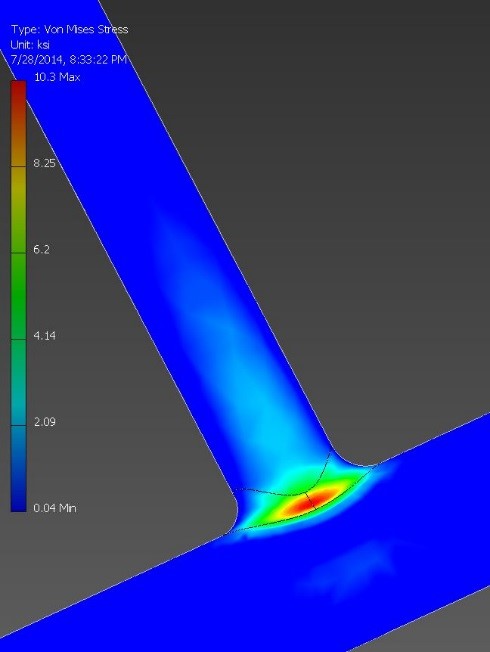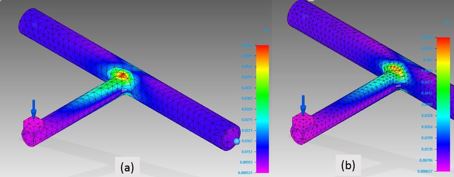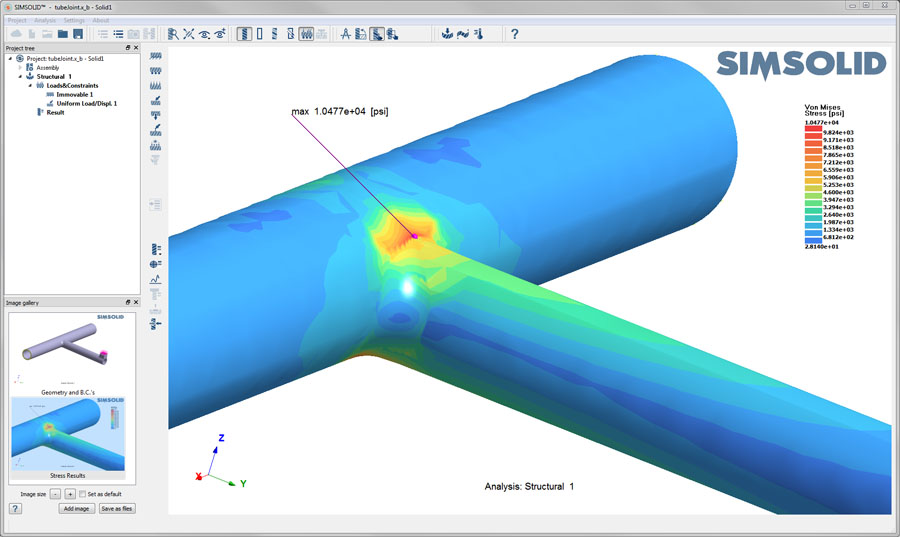Comparing Altair SimSolid with a FEA Benchmark
In order to try out Altair SimSolid, I wanted to compare it to a study previously done using traditional FEA. The model selected was a welded tube joint. This is typical of joints commonly found in industry and from past experience I have found that conventional FEA codes have a difficult time achieving accurate results at stress concentration points, such as at the intersection of the two tube sections in this model.
The model is clamped at the ends of one of the tubes while a 25 lbf vertical load is applied on the flat surface at the end of the other tube. The reference answer of 10,300 psi for the maximum stress was determined by successively manually refining the mesh using the well-established commercial automesher FEMAP, and solving the results in NX/Nastran. The same results was achieved using a very fine mesh with Autodesk Inventor simulation. Obtaining this result involved the time consuming process of successively refining the mesh and re-running the analysis until the maximum stress converged. The converged mesh required about 100,000 elements, and the result is show in Fig. 1.

Fig. 1 Results for FEA analysis using an extremely fine mesh
Solving this model with the default settings of FEMAP and NX/Nastran, using 10-node tetrahedral elements, gave the result in Fig 2(a). The results look qualitatively reasonable, but are in error by 41% (maximum stress 6,060 psi. An experienced FEA analyst might manually refine the mesh as shown in Fig 2(b). However, this led to a result of 7,078 psi, that was still in error by 24%.

Fig.2 Results from NX/Nastran using the default mesh (a), and a manually refined mesh (b)
This model was also analyzed with Autodesk Inventor simulation, which has an adaptive automesher that is at least as powerful as those in most commercial FEA codes. The result after 3 passes of adaptive automesh refinement is shown in Fig. 3. Again, the results look qualitatively good, but the results was 7,500 psi for the maximum stress, in error by 27%.

Fig.3 Result after 3 passes of adaptive mesh refinement in Autodesk Inventor Simulation
Finally a meshless adaptive analysis was performed on the model in Altair SimSolid. All default settings were used. The result is shown in Fig. 4. The Altair SimSolid result for the maximum stress was 10,477 psi, accurate to my reference result within 1.7%.

Fig.4. Result of meshless adaptive analysis in Altair SimSolid
My initial experience with Altair SimSolid was positive. Since it uses a meshless method, setup of the model was simple and straightforward. Best of all, I found the adaptive analysis gave an accurate result in the high stress regions without all the hassle of meshing and remeshing that is typical with traditional FEA. This seems to be a great tool for design-simulation.
- Article submitted by Richard King




